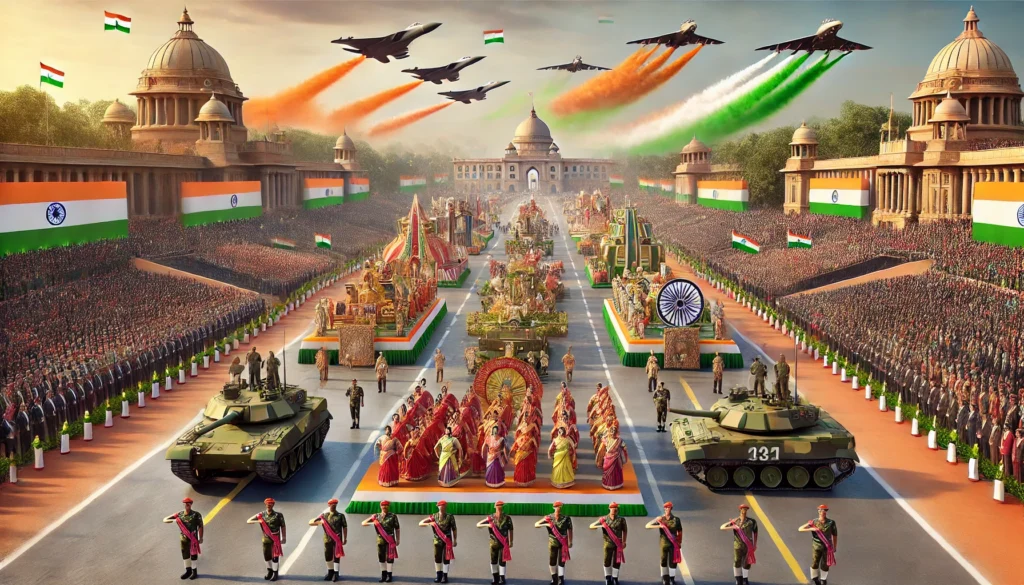
This article has neem written by Yashika Gupta, a final-year law student pursuing a B.A. LL.B. at the Sardar Patel Subharti Institute of Law.
Abstract
The Republic Day Parade, held annually on January 26 in New Delhi, is one of India’s most significant national celebrations. It marks the adoption of the Indian Constitution in 1950, transforming the country into a sovereign republic. Over the decades, the parade has evolved from a modest ceremony to a grand spectacle that showcases India’s military might, cultural richness, and democratic values. The parade is not only a display of military strength but also a vivid representation of the country’s diversity, as various states present tableaux depicting their unique heritage, traditions, and achievements. This article delves into the history, development, and significance of the Republic Day Parade, exploring its origins and how it has grown into a global event. The key elements of the parade, including military contingents, state tableaux, school performances, and the flypast by the Indian Air Force, are discussed in detail. Additionally, the article highlights the meticulous planning, coordination, and management required to organize such a large-scale event, including the role of various government agencies, security protocols, and the extensive preparations involved. Through this exploration, the article underscores the importance of the Republic Day Parade as a symbol of national unity, pride, and progress. It serves as a reminder of India’s democratic journey and offers a platform for citizens and global audiences alike to celebrate the country’s collective identity and enduring commitment to the values enshrined in its Constitution.
Key Words: Indian Constitution, Military Display, Cultural Diversity, National Unity, India’s Heritage, Democratic Values.
Introduction
Republic Day, celebrated on January 26 every year, marks the adoption of the Indian Constitution and the birth of India as a democratic republic. It’s a day of immense significance, symbolizing the country’s unity, diversity, and commitment to justice and equality. While the celebrations take place nationwide, the grandest of them all is the Republic Day Parade held in New Delhi. This event is a dazzling display of India’s rich cultural heritage, military and diverse traditions. The parade held at Rajpath in the national capital, features performances by various military units, colorful tableaux representing different states, and a stunning aerial display by the Indian Air Force. The Republic Day Parade serves as an important reminder of the country’s long struggle for independence and the sacrifices made by those who fought for a free and democratic India. More than just a national holiday, it is an occasion for every citizen to reflect on the journey the nation has undertaken since its founding and the collective responsibility of continuing to shape India’s future. Each year, millions of spectators gather on the streets of Delhi, while millions more watch from their homes across India and around the world. The event has grown beyond national borders, with international guests, dignitaries, and diplomatic representatives witnessing this extraordinary display of India’s strength and unity. From the grandeur of the military contingents to the cultural performances that showcase the diverse traditions of India’s many states, the Republic Day Parade offers a unique window into the heart of the nation[1].
Overview of the 26th January 2025 Republic Day Parade
Major Events:
- Flag Hoisting and National Anthem: The day began with the traditional flag hoisting ceremony, followed by the national anthem. President Droupadi Murmu presided over the ceremony, marking the 74th Republic Day of India.
- Gallantry Awards and Honors: The ceremony included the presentation of Gallantry Awards to armed forces personnel and civilians who have demonstrated exceptional bravery. This year’s recipients included soldiers and first responders who displayed courage during natural disasters and anti-terrorism operations.
- Military and Police Marches: The Indian Armed Forces, including the Army, Navy, and Air Force, marched proudly, presenting their advanced weaponry and combat systems. Police forces, along with specialized units, showcased their contributions to internal security.
- Flypast by the Indian Air Force: The grand flypast by the Indian Air Force featured a variety of aircraft, including fighter jets like the Sukhoi Su-30MKI, Rafales, and advanced helicopters. The flypast symbolized India’s defense capabilities and national security.
Minor Events:
- Cultural Performances: School children and folk artists participated, performing dances and songs from various Indian states. This section of the parade emphasizes India’s diversity and the unity in its cultural richness[2].
- Republic Day Awards: The awards ceremony celebrated excellence in various fields, such as sports, arts, science, and social service. Notable individuals were recognized for their extraordinary contributions to India’s progress.
- Special Guests and Tributes: Veterans, martyrs’ families, and distinguished citizens were acknowledged for their contributions. A special segment was dedicated to honoring the lives lost in the recent natural disasters and acts of terrorism.
History of the Republic Day Parade
- Origin of Republic Day[3]
On January 26, 1950, India officially became a republic with the adoption of the Indian Constitution. The day, previously celebrated as the “Independence Day” during the British colonial rule, now marked the country’s transition from a British dominion to a republic governed by its own Constitution. The first Republic Day celebration was a modest affair, attended by President Dr. Rajendra Prasad, with a brief parade that included military units and cultural performances.
The choice of January 26 as the Republic Day had a deep historical significance. On this day in 1930, the Indian National Congress had declared the Purna Swaraj (complete independence) resolution. This added a patriotic dimension to the occasion, connecting the celebration of India’s republic status with its freedom struggle.
- Evolution of the Parade
The Republic Day Parade, which began as a relatively simple military ceremony in the early years, evolved into a grand spectacle over the decades. The parade’s first venue was the Irwin Amphitheatre (known as National Stadium) but by 1955, the event moved to its current location, Rajpath near India Gate which offers a larger space to accommodate the growing number of spectators and participants[4].
Over time, the parade began to include a variety of components such as the participation of different states, the showcasing of the Indian Armed Forces’ capabilities, and the vibrant cultural diversity of India. Military divisions, including tanks, artillery, and marching bands, began to play a prominent role, reflecting India’s military strength and the professionalism of its defense forces.
International Recognition
In the 21st century, the Republic Day Parade has gained widespread recognition not only within India but globally. The parade, broadcast to millions of people worldwide, highlights the progress India has made since gaining independence. The participation of foreign dignitaries[5], who are invited as chief guests, also underscores the significance of this event in the international diplomatic arena. So, as the Republic Day Parade was recognised internationally or globally, inviting several Chief Guest was incorporated to showcase the Nationality, Culture and democracy of India. There are several members who were invited as the Chief Guest from various Nation/ Countries during last 5 years who belong to respective Countries are as follows:-
| 2019 | President Cyril Ramaphosa | South Africa |
| 2020 | President Jair Bolsonaro | Brazil |
| 2021 | No Chief Guest (due to COVID-19) | – |
| 2022 | No Chief Guest (due to COVID-19) | – |
| 2023 | President Abdel Fattah al-Sisi | Egypt |
| 2024 | Emmanuel Macron | France |
| 2025 | President Prawobo Subianto | Indonesia |
Development of the Republic Day Parade
- Early Days of the Parade (1950-1960s)
The first decade of Republic Day celebrations saw limited participation. The early parades focused on showcasing the military strength of the country, with only a few divisions taking part. Over time, the parade grew to include different branches of the Indian Armed Forces, with the addition of the Army, Navy, and Air Force, as well as the police forces from various states.
During this period, the parade’s cultural segment began to take shape, with performances from schoolchildren and displays representing the cultural diversity of India. However, the parade was still quite simple, focusing mainly on military formations and ceremonial elements.
- The 1970s-1980s: A National Spectacle
By the 1970s, the Republic Day Parade had become a much grand event, with increased participation from state governments. The introduction of state tableaux, which represent the culture, history, and achievements of each state, became a hallmark of the parade. These tableaux not only showcased India’s cultural richness but also emphasized the unity in diversity that the nation cherishes.
Additionally, the period of 1980s saw the introduction of various forms of cultural performances, including folk dances, music, and vibrant displays of regional art. The participation of children from schools across the country further enriched the parade, with students performing songs and dances that represented different parts of India.
- The Modern Era (1990s-Present)
In the 1990s, the Republic Day Parade became more technologically advanced. The live broadcast of the parade reached global audiences, and international dignitaries began attending the event more frequently. The parade began incorporating new technologies, such as satellite transmissions, high-definition broadcasts, and real-time streaming over the internet, further amplifying its global reach.
The parade’s modern version now reflects not just India’s military power and cultural diversity but also its technological advancements and global stature. The inclusion of international performers, foreign military bands, and guest dignitaries have transformed the event into a major diplomatic and cultural celebration.
Themes of the Last Three Years’ Parades and their Significance:
- 2025 – “Women Empowerment: Progress and Participation”: The theme emphasized the increasing role of women in all spheres of life, highlighting their contributions in defense, science, politics, and sports. This was in alignment with India’s push for gender equality and women’s rights.
- 2024 – “Sustainable Development and Green Initiatives”: This theme focused on India’s commitment to sustainable growth and environmental protection. The focus was on green technologies, reducing carbon emissions, and promoting clean energy.
- 2023 – “Unity in Diversity”: A classic theme celebrating India’s pluralism, this year’s parade paid tribute to the country’s diversity in culture, religion, language, and geography. The theme underscored India’s core value of harmony and coexistence.
- Comparison of Themes:
- 2025’s theme of “Women Empowerment” reflected India’s growing recognition of women’s contributions, aiming to inspire future generations to break societal barriers.
- 2024’s took a more forward-looking stance with an environmental focus, showing India’s commitment to addressing climate change and its role in global sustainability.
- 2023’s theme focused on the unity and diversity of India, celebrating how the nation’s multiple identities coexist.
Key Elements of the Republic Day Parade
- The Route and Structure
The Republic Day Parade takes place on Rajpath, a ceremonial boulevard that stretches from Rashtrapati Bhavan (the President’s residence) to India Gate. The route is symbolic, connecting the residence of the President (the head of the state) with the memorial of soldiers who sacrificed their lives for the nation.
The parade begins with the arrival of the President of India, who is greeted with a 21-gun salute and then takes the salute from the various contingents as they march past. The ceremonial parade includes performances by the Armed Forces, police, and cultural contingents from across the nation. The President is accompanied by the Chief Guest (the foreign dignitary) as they review the parade from the special dais at Rajpath.
- The Military Presence
The Republic Day Parade is a showcase of India’s military strength. The parade features various divisions of the Indian Armed Forces, including the Army, Navy, and Air Force. The Armed Forces’[6] contingent is led by a senior officer, followed by divisions such as infantry, artillery, tanks, and mechanized columns.
One of the most spectacular features of the parade is the display of advanced military hardware, such as missiles, tanks, and artillery. The parade also includes flypasts by fighter jets and helicopters, highlighting India’s defense capabilities and air superiority.
- Tableaux and Cultural Showcases
The tableaux section is one of the most eagerly awaited parts of the parade. Each state of India presents a tableau that reflects its cultural diversity, historical significance, and achievements. These tableaux are intricately designed and feature traditional art forms, folk dances, and local crafts.
In addition to the state tableaux, various government departments, ministries, and organizations also showcase their contributions to the nation’s development. The cultural performances, often accompanied by vibrant music and dance, represent the country’s rich traditions and the unity that binds its people together.
The contribution of various States, Government Departments amd organizations by reflecting their cultural diversity are as follows:-
Kerala showcased its traditional dance forms and celebrated its advances in sustainable tourism, illustrating its rich cultural diversity and environmental consciousness.
Maharashtra’s tableau highlighted women’s empowerment through depictions of women in various fields like science, agriculture, and industry.
Karnataka presented a tableau featuring the Hampi ruins, an ancient UNESCO World Heritage site, coupled with its booming tech industry, symbolizing the state’s growth as a modern technology hub while preserving its heritage.
Uttar Pradesh won the Best Tableau award for the Kashi Vishwanath Corridor, a grand representation of the ongoing transformation in Varanasi, a city with centuries of spiritual and cultural significance. The tableau depicted the Kashi Vishwanath Temple, the newly constructed corridor connecting the temple to the banks of the Ganges, and the state’s development initiatives in preserving heritage while enhancing infrastructure. The tableau reflected Indi a’s delicate balance between modernity and tradition.
Revival of the ‘Buggy Tradition’ by President Murmu
In a significant move that stirred nostalgia and pride in India’s royal heritage, President Droupadi Murmu revived the traditional horse-drawn buggy during the 2025 Republic Day celebrations. The buggy, once used by Indian royalty and dignitaries, was a prominent part of Republic Day parades in the early years post-independence. However, over the decades, it had fallen into obscurity, being gradually replaced by more modern conveyances.
Significance of the Revival:
- The reintroduction of the buggy in 2025 symbolized a return to India’s royal past and its deep-rooted traditions. President Murmu’s decision to revive this historical aspect reflects her commitment to celebrating the country’s cultural richness and heritage.
- The buggy was drawn by well-trained horses, adding a regal touch to the ceremony, and it moved through Rajpath as part of the President’s ceremonial participation. It was seen as a tribute to India’s princely states and royal traditions, linking the country’s rich past with its modern identity.
- This revival also aimed to emphasize the fusion of India’s traditional values with its modern progress, highlighting the idea that while India moves forward, it should not forget its cultural roots.
The Role of School Children
Schoolchildren play an essential role in the Republic Day Parade, performing songs, dances, and drills. These performances highlight the contribution of the younger generation to nation building. Students from different regions of India participate in this segment, representing the diverse cultural landscape of the country.
Management of the Republic Day Parade
- The Organizing Bodies:
The Republic Day Parade is a massive logistical operation that involves multiple agencies and departments. The Ministry of Defence, through the Republic Day Committee, is responsible for the overall organization of the event. The Indian Armed Forces, particularly the Army, play a key role in planning and executing the parade, from military formations to the display of equipment.
Other agencies involved include the Delhi Police, the Fire Department, and various emergency services. The coordination between these entities ensures that the parade is executed smoothly and safely.
- Planning and Preparation:
The planning for the Republic Day Parade begins months in advance. Rehearsals for the military units and cultural performances typically begin in mid-December. These rehearsals involve precise coordination between the different contingents, which includes practice runs on the parade route.
The preparation for the tableaux also begins months in advance. State governments and cultural organizations work to design and build the elaborate floats that will represent their regions. These floats are then transported to Delhi, where they are carefully positioned and adjusted for the parade.
- Ensuring Safety and Security:
Given the scale of the event, security is a top priority during the Republic Day Parade. The Delhi Police, along with other intelligence agencies, put in place rigorous security measures. These include checks at entry points, surveillance of the surrounding areas, and control of crowd movement. The National Disaster Response Force (NDRF) is also on standby in case of any emergencies
The Republic Day Parade Process
- The Opening Ceremony
The Republic Day Parade officially begins with the arrival of the President of India at Rajpath, where he is greeted by a 21-gun salute. This is followed by the hoisting of the national flag, after which the President delivers a speech outlining the nation’s achievements and goals. The parade then begins, with military divisions and cultural groups marching past the President.
- The Parade Stages
The parade is organized into distinct segments: first, the military contingents, followed by the police forces, and finally, the tableaux and cultural performances. Each segment has its own significance, whether it be showcasing India’s defense strength, honoring the police forces, or celebrating the cultural heritage of the states.
The most spectacular segment of the parade is the flypast by the Indian Air Force. The jets perform intricate aerial maneuvers, concluding with the iconic “Tricolor Smoke” when they leave a trail of the national colors in the sky.
Other Relevant Information
- Technological Innovation and Drone Show: For the first time, the 2025 Republic Day Parade featured a drone light show. This high-tech display illuminated the skies over Rajpath, combining art and innovation. The light show was carefully choreographed, displaying a variety of patterns and symbols that included the Indian national flag, Bharat Mata, and symbols of unity and progress. The show was designed to reflect the country’s growing emphasis on technology and innovation, and it was a spectacular way to end the parade, leaving the audience in awe of India’s technological prowess.
- Health and Safety Protocols: In the aftermath of the COVID-19 pandemic, the Government of India maintained a careful approach to crowd management and safety. While the event was celebrated with the usual grandeur, there were stringent health protocols in place. Attendees, participants, and officials followed COVID-appropriate behavior, ensuring that the celebrations were both safe and enjoyable. This was an important aspect, as it showed India’s resilience in returning to normalcy post-pandemic.
- International Relations and Diplomacy: Having Fumio Kishida, the Prime Minister of Japan, as the Chief Guest for the 2025 Republic Day Parade highlighted India’s strengthening relationship with Japan. The choice was symbolic of India’s strategic ties with Japan, especially in the context of Indo-Pacific security, trade, and technology exchange. This high-profile visit was a diplomatic statement, underscoring India’s role as a key player in the region and in international affairs.
- Acknowledgment of National Achievements: Alongside the traditional celebrations, there was a clear focus on India’s achievements in various sectors like space exploration, defense capabilities, and economic development. The ISRO (Indian Space Research Organisation) showcased models of its recent advancements, including the Chandrayaan-3 mission to the Moon and the Gaganyaan mission, India’s ambitious human spaceflight project.
- Awarding of Gallantry Decorations: As part of the Republic Day celebrations, soldiers, police personnel, and civilians who had shown exceptional courage in the face of adversity were honored with gallantry awards. This year, the President awarded soldiers for their valor in anti-terrorism operations and disaster relief efforts. It was a powerful reminder of the bravery and dedication of India’s defense forces, paramilitary units, and emergency responders.
Conclusion
The Republic Day Parade is much more than a ceremonial event; it is a powerful reflection of India’s national identity, the sacrifices made during its independence struggle, and its ongoing commitment to upholding the values enshrined in its Constitution. As one of the most important national celebrations, the parade brings to the forefront not just the country’s military strength, but also the immense cultural diversity, unity, and democratic spirit that define India. Each year, as the parade unfolds along Rajpath, it serves as a reminder of how far the nation has come and the collective responsibility every citizen shares in maintaining its democratic ideals. From its modest beginnings in 1950, the Republic Day Parade has grown into a world-renowned event, attracting global attention while keeping alive the legacy of India’s freedom movement. The transition from a simple display of military might to a multi-faceted celebration that includes cultural performances, state tableaux, and school participation mirrors the country’s evolution into a modern republic that values both tradition and progress. The inclusion of foreign dignitaries as chief guests further underscores India’s role as a rising power on the world stage, while also emphasizing the spirit of global diplomacy and cooperation. The meticulous planning and management required to execute such a grand spectacle demonstrate the country’s organizational capabilities and dedication to showcasing its national pride. The involvement of various sectors, from the military to local communities, illustrates the collaboration needed to bring this event to life.
Furthermore, the parade acts as a testament to India’s pluralistic society, where regional diversity, ethnic traditions, and different languages are celebrated as part of a shared national identity. As the final flypast by the Indian Air Force roars across the sky, trailing the colors of the national flag, the Republic Day Parade leaves an indelible mark on the hearts and minds of millions, both in India and around the world. It serves as a poignant reminder of the nation’s journey from colonial rule to independence, and from independence to a thriving democratic republic. This day, this parade, is an embodiment of the strength, resilience, and hopes of the Indian people, and it continues to inspire generations to work toward preserving the ideals of freedom, equality, and justice for all. The Republic Day Parade will remain, for years to come, a living celebration of India’s past, present, and future.
References
https://economictimes.indiatimes.com/news/newsblogs/republic-day-2025
https://knowindia.india.gov.in/republic-day-celebration/celebrations.php
https://pib.gov.in/PressReleasePage.aspx?PRID=2094644
[1] https://pib.gov.in/PressReleasePage.aspx?PRID=1234567.
[2] https://www.bbc.com/news/world/india-6791235.
[3] https://www.hindustantimes.com/india-news/republic-day-parade-to-showcase-indias-military-strength-1016740539.html.
[4] https://en.wikipedia.org/wiki/Republic_Day_of_India.
[5] https://www.ndtv.com/india-news/celebrating-republic-day-highlights-of-the-military-parade-2025-article-2557895.
[6] https://timesofindia.indiatimes.com/india/republic-day-2025-highlights/articleshow/679349540.cms.







